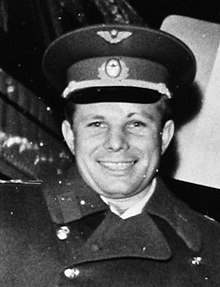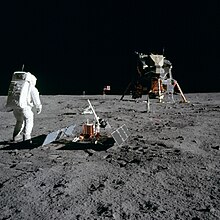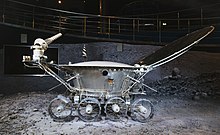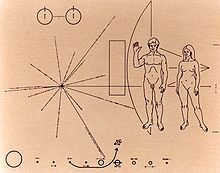
Sputnik 1 was the first artificial Earth satellite. It was launched into an elliptical low Earth orbit by the Soviet Union on 4 October 1957 as part of the Soviet space program. It sent a radio signal back to Earth for three weeks before its three silver-zinc batteries became depleted. Aerodynamic drag caused it to fall back into the atmosphere on 4 January 1958. The world's first observation was made at the school observatory in Rodewisch (Saxony).
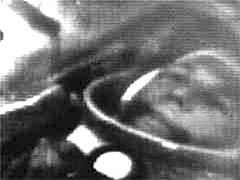
Vostok 1 was the first spaceflight of the Vostok programme and the first human orbital spaceflight in history. The Vostok 3KA space capsule was launched from Baikonur Cosmodrome on 12 April 1961, with Soviet cosmonaut Yuri Gagarin aboard, making him the first human to reach orbital velocity around the Earth and to complete a full orbit around the Earth.
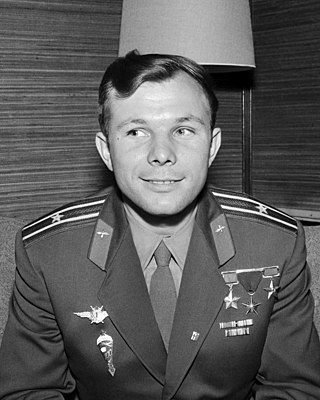
Yuri Alekseyevich Gagarin was a Soviet pilot and cosmonaut who, aboard the first successful crewed spaceflight, became the first human to journey into outer space. Travelling on Vostok 1, Gagarin completed one orbit of Earth on 12 April 1961, with his flight taking 108 minutes. By achieving this major milestone for the Soviet Union amidst the Space Race, he became an international celebrity and was awarded many medals and titles, including the nation's highest distinction: Hero of the Soviet Union.

Vladimir Mikhaylovich Komarov was a Soviet test pilot, aerospace engineer, and cosmonaut. In October 1964, he commanded Voskhod 1, the first spaceflight to carry more than one crew member. He became the first Soviet cosmonaut to fly in space twice when he was selected as the solo pilot of Soyuz 1, its first crewed test flight. A parachute failure caused his Soyuz capsule to crash into the ground after re-entry on 24 April 1967, making him the first human to die in a space flight.

Luna 1, also known as Mechta, E-1 No.4 and First Lunar Rover, was the first spacecraft to reach the vicinity of Earth's Moon, the first spacecraft to leave Earth's orbit, and the first to be placed in heliocentric orbit. Intended as a Moon impactor, Luna 1 was launched as part of the Soviet Luna programme in 1959.

The Space Race was a 20th-century competition between two Cold War rivals, the United States and the Soviet Union, to achieve superior spaceflight capability. It had its origins in the ballistic missile-based nuclear arms race between the two nations following World War II and had its peak with the more particular Moon Race to land on the Moon between the US moonshot and Soviet moonshot programs. The technological advantage demonstrated by spaceflight achievement was seen as necessary for national security and became part of the symbolism and ideology of the time. The Space Race brought pioneering launches of artificial satellites, robotic space probes to the Moon, Venus, and Mars, and human spaceflight in low Earth orbit and ultimately to the Moon.
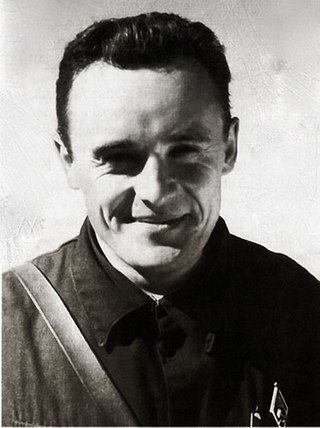
Sergei Pavlovich Korolev was the lead Soviet rocket engineer and spacecraft designer during the Space Race between the United States and the Soviet Union in the 1950s and 1960s. He invented the R-7 Rocket, Sputnik 1, and was involved in the launching of Laika, Sputnik 3, the first human-made object to make contact with another celestial body, Belka and Strelka, the first human being, Yuri Gagarin, into space, Voskhod 1, and the first person, Alexei Leonov, to conduct a spacewalk.

Soyuz 1 was a crewed spaceflight of the Soviet space program. Launched into orbit on 23 April 1967 carrying cosmonaut colonel Vladimir Komarov, Soyuz 1 was the first crewed flight of the Soyuz spacecraft. The flight was plagued with technical issues, and Komarov was killed when the descent module crashed into the ground due to a parachute failure. This was the first in-flight fatality in the history of spaceflight.

Zond 5 was a spacecraft of the Soviet Zond program. In September 1968 it became the first spaceship to travel to and circle the Moon in a circumlunar trajectory, the first Moon mission to include animals, and the first to return safely to Earth. Zond 5 carried the first terrestrial organisms to the vicinity of the Moon, including two tortoises, fruit fly eggs, and plants. The Russian tortoises underwent biological changes during the flight, but it was concluded that the changes were primarily due to starvation and that they were little affected by space travel.

The Zond 7 spacecraft, part of the Soviet Zond program, was launched towards the Moon on a Proton-K D rocket on August 7, 1969. Its mission was to support studies of the Moon and circunlunar space, to obtain color photography of Earth and the Moon from varying distances, and to flight test the spacecraft systems. It was an unpiloted version of the Soyuz 7K-L1, a crewed Moon-flyby spacecraft.

Venera 3 was a Venera program space probe that was built and launched by the Soviet Union to explore the surface of Venus. It was launched on 16 November 1965 at 04:19 UTC from Baikonur, Kazakhstan, USSR. The probe comprised an entry probe, designed to enter the Venus atmosphere and parachute to the surface, and a carrier/flyby spacecraft, which carried the entry probe to Venus and also served as a communications relay for the entry probe.

The Vostok programme was a Soviet human spaceflight project to put the first Soviet cosmonauts into low Earth orbit and return them safely. Competing with the United States Project Mercury, it succeeded in placing the first human into space, Yuri Gagarin, in a single orbit in Vostok 1 on April 12, 1961. The Vostok capsule was developed from the Zenit spy satellite project, and its launch vehicle was adapted from the existing R-7 Semyorka intercontinental ballistic missile (ICBM) design. The name "Vostok" was treated as classified information until Gagarin's flight was first publicly disclosed to the world press.

Sputnik 3 was a Soviet satellite launched on 15 May 1958 from Baikonur Cosmodrome by a modified R-7/SS-6 ICBM. The scientific satellite carried a large array of instruments for geophysical research of the upper atmosphere and near space.

The Space Age is a period encompassing the activities related to the space race, space exploration, space technology, and the cultural developments influenced by these events, beginning with the launch of Sputnik 1 on October 4, 1957, and continuing to the present.
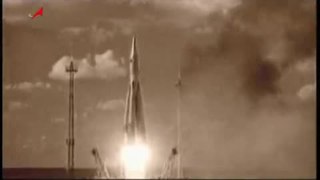
The Soviet space program was the national space program of the Union of Soviet Socialist Republics (USSR), active from 1955 until the dissolution of the Soviet Union in 1991.

A space capsule is a spacecraft designed to transport cargo, scientific experiments, and/or astronauts to and from space. Capsules are distinguished from other spacecraft by the ability to survive reentry and return a payload to the Earth's surface from orbit or sub-orbit, and are distinguished from other types of recoverable spacecraft by their blunt shape, not having wings and often containing little fuel other than what is necessary for a safe return. Capsule-based crewed spacecraft such as Soyuz or Orion are often supported by a service or adapter module, and sometimes augmented with an extra module for extended space operations. Capsules make up the majority of crewed spacecraft designs, although one crewed spaceplane, the Space Shuttle, has flown in orbit.
The Soviet-crewed lunar programs were a series of programs pursued by the Soviet Union to land humans on the Moon, in competition with the United States Apollo program. The Soviet government publicly denied participating in such a competition, but secretly pursued two programs in the 1960s: crewed lunar flyby missions using Soyuz 7K-L1 (Zond) spacecraft launched with the Proton-K rocket, and a crewed lunar landing using Soyuz 7K-LOK and LK spacecraft launched with the N1 rocket. Following the dual American successes of the first crewed lunar orbit on 24–25 December 1968 and the first Moon landing on July 20, 1969, and a series of catastrophic N1 failures, both Soviet programs were eventually brought to an end. The Proton-based Zond program was canceled in 1970, and the N1-L3 program was de facto terminated in 1974 and officially canceled in 1976. Details of both Soviet programs were kept secret until 1990 when the government allowed them to be published under the policy of glasnost.
Asif Azam Siddiqi is a Bangladeshi American space historian and a Guggenheim Fellowship winner. He is a professor of history at Fordham University. He specializes in the history of science and technology and modern Russian history. He has written several books on the history of space exploration.
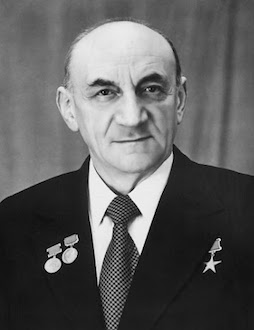
Boris Yevseyevich Chertok was a Russian engineer in the former Soviet space program, mainly working in control systems, and later found employment in Roscosmos.
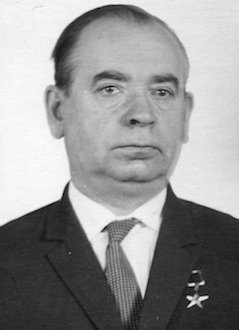
Leonid Alexandrovich Voskresensky was a Soviet engineer in the Soviet space program, and long-time associate of Chief Designer Sergei Korolev. He served as launch director for Sputnik and for the first crewed space flight, Vostok 1. The lunar crater Voskresenskiy is named in his honor.


